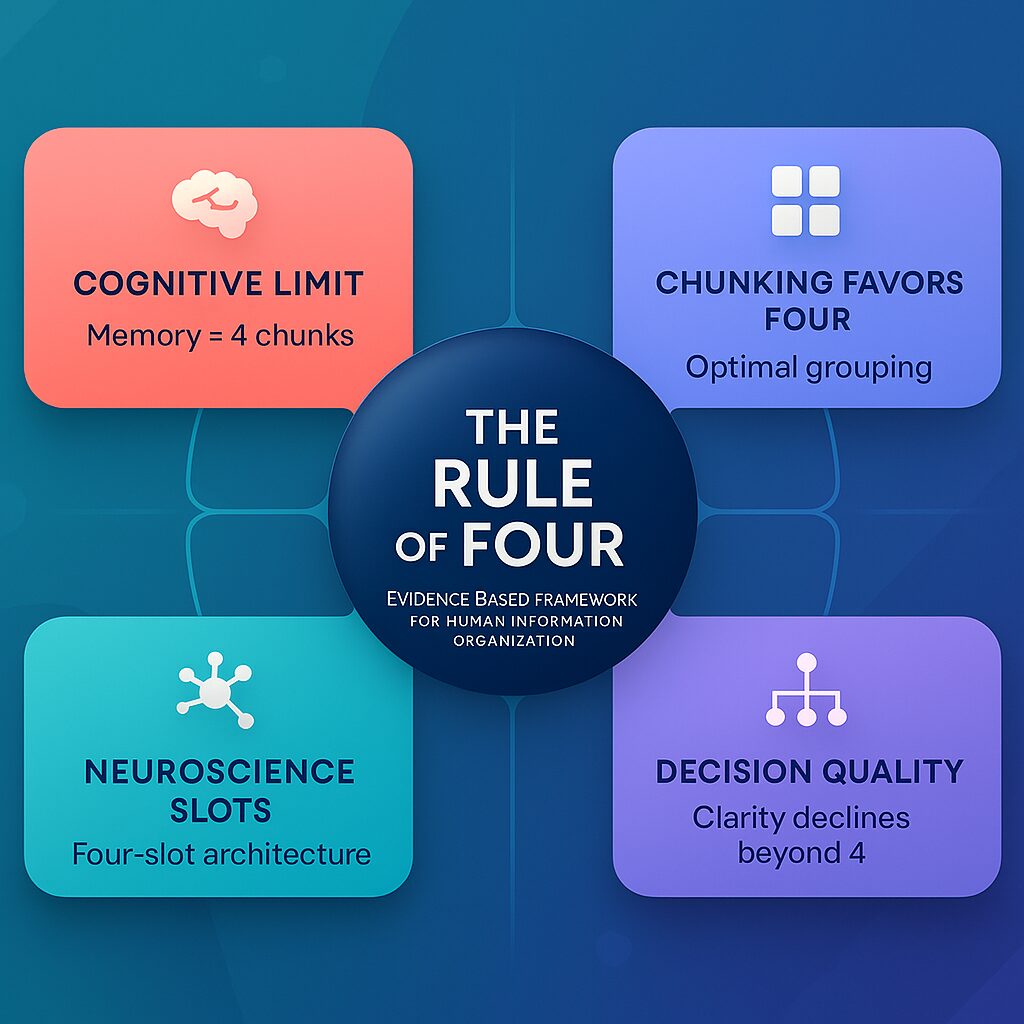Introduction
We’re surrounded by information. Feeds scroll forever, inboxes refill faster than we can clear them, and every new tool promises to streamline the chaos yet most people still end the day mentally spent. The solution often isn’t another app; it’s structure. Enter the Rule of Four: a timeless framework that matches how the human mind handles complexity. In sets of four, data stops feeling like noise and starts feeling like knowledge you can act on.
1. The Four‑Chamber Mind
Modern cognitive science shows that our working‑memory capacity peaks at roughly four “chunks” of information. Push past that and recall plummets. Psychologist Nelson Cowan’s research, among others, pinpoints this range dispelling the old “7±2” myth. Four is our natural ceiling; you can feel it when you try to juggle five facts in your head and the first one slips away.
Key Takeaway: Four isn’t arbitrary. It’s the brain’s built‑in bandwidth.
2. Why Chunking Loves Four
We instinctively group items to lighten cognitive load. This “chunking” works best when each bundle contains three to five elements, with four dead‑center. Think of how we remember phone numbers in clusters or how designers use four quadrants for quick visual scanning. Chunking around four balances detail with digestibility.
3. Decision Quality Falls Off a Cliff After Four
Studies on choice architecture reveal a tipping point: offer people more than four options and clarity erodes. Reaction time slows, confidence drops, and satisfaction with the final decision shrinks. Retail strategists know it; neuroscience confirms it. Four choices feel empowering. Ten choices feel like homework.
4. The Neuroscience Slots
FMRI studies suggest that working memory operates via discrete neural “slots.” Most adults get four. Children, older adults, and distracted thinkers may get three or fewer on a bad day. Structure content in fours and you align with your audience’s hardware. Structure it in eights and you force them to off‑load the excess to paper or forget it entirely.
5. Recognizing the Rule in Everyday Life
- Cardinal Directions: North, South, East, West.
- Seasons: Spring, Summer, Fall, Winter.
- Story Structure: Setup, Confrontation, Climax, Resolution.
- Business Metrics: Leads, Conversions, Revenue, Retention.
The pattern repeats because it works. Humanity keeps returning to fours because they’re easy to remember and easy to act on.
6. Putting the Rule of Four to Work
- Sort Before You Store – Break any project, plan, or briefing into four top‑level categories.
- Label Clearly – Use short, punchy headings; they become cognitive anchor points.
- Limit Alternatives – If you brainstorm more than four big ideas, rank them and file the extras under “Later.”
- Review Quarterly – Four times a year is often enough to realign goals without drowning in revision.
These steps don’t require new software. They require restraint and deliberate structuring skills any leader can cultivate.
7. Frequently Asked Questions
Q: Is four always the perfect number?
A: It’s the upper bound for effortless processing. You can group things in threes if symmetry isn’t essential, but fives and sixes invite overload.
Q: What about experts who manage complex systems?
A: Experts chunk information into larger familiar units. Even they often nest complexity within four or fewer top‑level buckets.
Q: Does this replace detailed documentation?
A: No. The Rule of Four organizes the overview. Drill‑down details live inside each bucket.
8. Final Thoughts
Information isn’t slowing down, and willpower alone won’t save us from overload. Structure will. The Rule of Four gives you a mental scaffolding that respects biological limits while leaving room for nuance. Next time your plan, deck, or dataset feels unwieldy, try framing it in fours. You’ll see the clutter fall away and the essentials stand clear.
